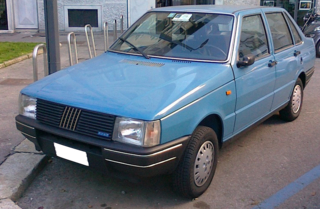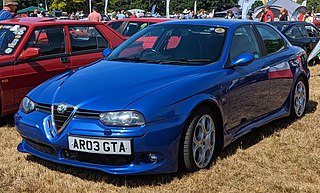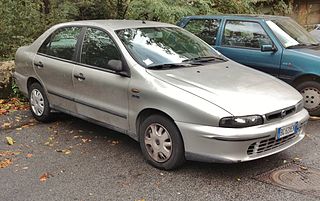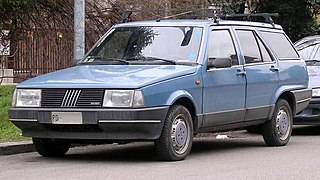
The Fiat Croma name was used for two distinct large family cars by Fiat, one a five door liftback manufactured and marketed from 1985 to 1996, and after a nine-year hiatus, a crossover station wagon manufactured and marketed from 2005 to 2010.

The Fiat Uno is a supermini manufactured and marketed by Fiat. Launched in 1983, the Uno was produced over a single generation in three and five-door hatchback body styles until 1995 in Europe — and until 1 January 2014, in Brazil. Designed by Giorgetto Giugiaro of Italdesign, the Uno strongly recalled the high-roof, up-right packaging of Giugiaro's 1978 Lancia Megagamma concept, in a smaller configuration.

The Fiat Palio is a supermini car released by the Italian manufacturer Fiat in April 1996. It was produced until 2020.

The Fiat Duna is a small car produced by Fiat in Argentina and Brazil, where it was sold as Fiat Prêmio. Launched in 1985 in Brazil, the Duna/Prêmio is based on the Brazilian Fiat Uno, but unlike the Uno, it was a two-door sedan. The range was expanded with a three-door estate in 1987 called the Fiat Elba, a four-door sedan added in 1987 and a five-door estate in 1989. The car was sold mainly in South America. Production ended in 2000 and the Duna and Elba models were replaced by the Fiat Siena and the Fiat Palio Weekend. The Duna was the best-selling car in Argentina between the years 1990 and 1995.

The Fiat Tempra is a small family car produced by the Italian automaker Fiat from 1990 to 1996 in Italy. The Tempra was intended as a replacement for the Fiat Regata. The original project was called Tipo 3, being a mid-size car between the Fiat Tipo and the bigger Fiat Croma. The Tempra shares its Type Three platform with the Lancia Dedra and Alfa Romeo 155.

The Alfa Romeo 156 is a compact executive car produced by the Italian automobile manufacturer Alfa Romeo. It was introduced at the 1997 Frankfurt Motor Show as the replacement for the Alfa Romeo 155. The 156 received a positive reception and in the following year went on to win the 1998 European Car of the Year award. The 156 saloon was discontinued in Europe late in 2005, while the Q4 Crosswagon continued in production until the end of 2007.

The Fiat Ritmo is a small, front-engine, front-wheel drive family car manufactured and marketed by Fiat, launched in April 1978 at the Turin Motor show and offered in 3- and 5-door hatchback and cabriolet body styles – from 1978 to 1988 with two facelifts.

The Fiat 131 is a family car manufactured and marketed by Fiat from 1974 to 1984 after its debut at the 1974 Turin Motor Show. Available as a two-door and four-door saloon and 5-door estate across a single generation, the 131 succeeded the Fiat 124.

The Fiat Marea is a small family car available as a saloon and an estate, produced by the Italian automaker Fiat. Launched in September 1996, the Marea models were essentially different body styles of Fiat's hatchback offerings, the Bravo and Brava. The Marea replaced the earlier Tipo based Fiat Tempra, as well as the larger Croma.
Multijet is Stellantis's term for its current common rail direct injection turbodiesel engine range. Most of the Fiat, Alfa Romeo, and Lancia range, as well as certain Chrysler, RAM Trucks, Jeep, and Maserati vehicles, are equipped with Multijet engines. Ownership of some Fiat Multijet designs is shared with General Motors as part of a settlement of the failed merger between the two auto conglomerates. The GM Powertrain Torino group in Turin, Italy, manages its interest in these engines. Some PSA Peugeot Citroën diesel engines are also rebadged JTD units, and vice versa. Fiat's common-rail diesel engine is also known as JTD, an initialism of Jet Turbo Diesel.

The Fiat Fiorino is a small commercial vehicle produced by the Italian car manufacturer Fiat since 1977. Its first two generations have been the panel van derivatives of other small models, such as the Fiat 127 and Fiat Uno, while the current third generation was developed jointly with PSA Peugeot Citroën, and is based on the Fiat Small platform.
1989 in motoring includes developments in the automotive industry throughout the year 1989 by various automobile manufacturers, grouped by country. The automotive industry designs, develops, manufactures, markets, and sells motor vehicles.

The Corolla E70 was the fourth generation of cars sold by Toyota under the Corolla nameplate.

The Corolla E90, introduced in 1987 for the 1988 model year, was the sixth generation of cars sold by Toyota under the Corolla nameplate. It was the last generation of Corolla to be classified as a subcompact car and the first to be exclusively front-wheel drive or all-wheel drive; the performance option of rear-wheel drive was dropped.

Marengo is a model name that Italian car maker Fiat has given to the van derivatives of its mid size cars, beginning with the "Fiat 131 Marengo" in 1979 and continuing with the Regata, Tempra, and Marea. The Marengo light commercial vehicle derivatives only have two seats, and have only been equipped with diesel engines.

In 2015 Spain produced 2.7 million cars which made it the 8th largest automobile producer country in the world and the 2nd largest car manufacturer in Europe after Germany a position in the ranking that it was still keeping in 2024. Approximately 80% of that production is for export. During the first half of 2016, with exports valued over 24 billion euros over that period, the automotive industry accounted for 18.9% of the total Spanish exports.

The Volkswagen Passat is a front-engine D-segment large family car manufactured and marketed by Volkswagen from 2005 to 2011 (B6) and from 2010 to 2015. Respectively the six and seventh generation Passat, and internally designated B6 and B7, they were marketed in sedan and wagon bodystyles in front-wheel as well as all-wheel drive configurations, with a range of petrol and diesel engines.

Designed by Aurelio Lampredi, the Fiat 124 engine first appeared in the all-new Fiat 124 in April 1966. The in-line four-cylinder engine comprised an iron block with an aluminium cylinder-head with pushrod actuated valves. The belt-driven design was ahead of its time when introduced. European production of the petrol versions ended with the Fiat 131 in 1984, but later diesel derivatives continued to be built until 1999. It did have a longer life in its twin-cam iteration, which continued in production until 2000. While originally of an overhead valve design, an overhead cam version was added to the facelifted 131 in 1981. The capacity was initially 1.2 L (1,197 cc), but eventually ranged between 1.2 and 1.9 L. There were also three SOHC diesel iterations of 1.4, 1.7, and 1.9 litres. The last versions of this engine to be built were the diesels. The 1.9 L (1,929 cc) direct-injected diesel version was the first direct-injection diesel to appear in a production passenger car, the Fiat Croma Turbo D i.d.

The Suzuki Ciaz is a subcompact sedan produced by Suzuki since 2014. It is developed to replace the Suzuki SX4 sedan in several Asian, African and Latin American markets. It went on sale for the first time in India, the largest market for Suzuki in September 2014. As of 2022, it is the larger model of two sedans produced by Suzuki, the other being the Dzire.

The Fiat Tipo is a compact car. A three-box sedan version was unveiled at the 2015 Istanbul Motor Show in May 2015, and commenced sales in Turkey in October 2015. In 2016, it was followed by a hatchback and a station wagon version, for the European market. The Tipo is assembled at the Tofaş plant in Bursa, Turkey, by the Italian automaker Fiat and is built on the Fiat Small Wide LWB platform. It replaced the Bravo and Linea in the C-segment range. The Tipo was designed by Centro Stile Fiat in Mirafiori, Turin. In December 2015, the car won the 2016 Best Buy Car of Europe Award, from the Autobest jury made up of Europe's twenty-six leading journalists, from twenty-six different European countries.
























